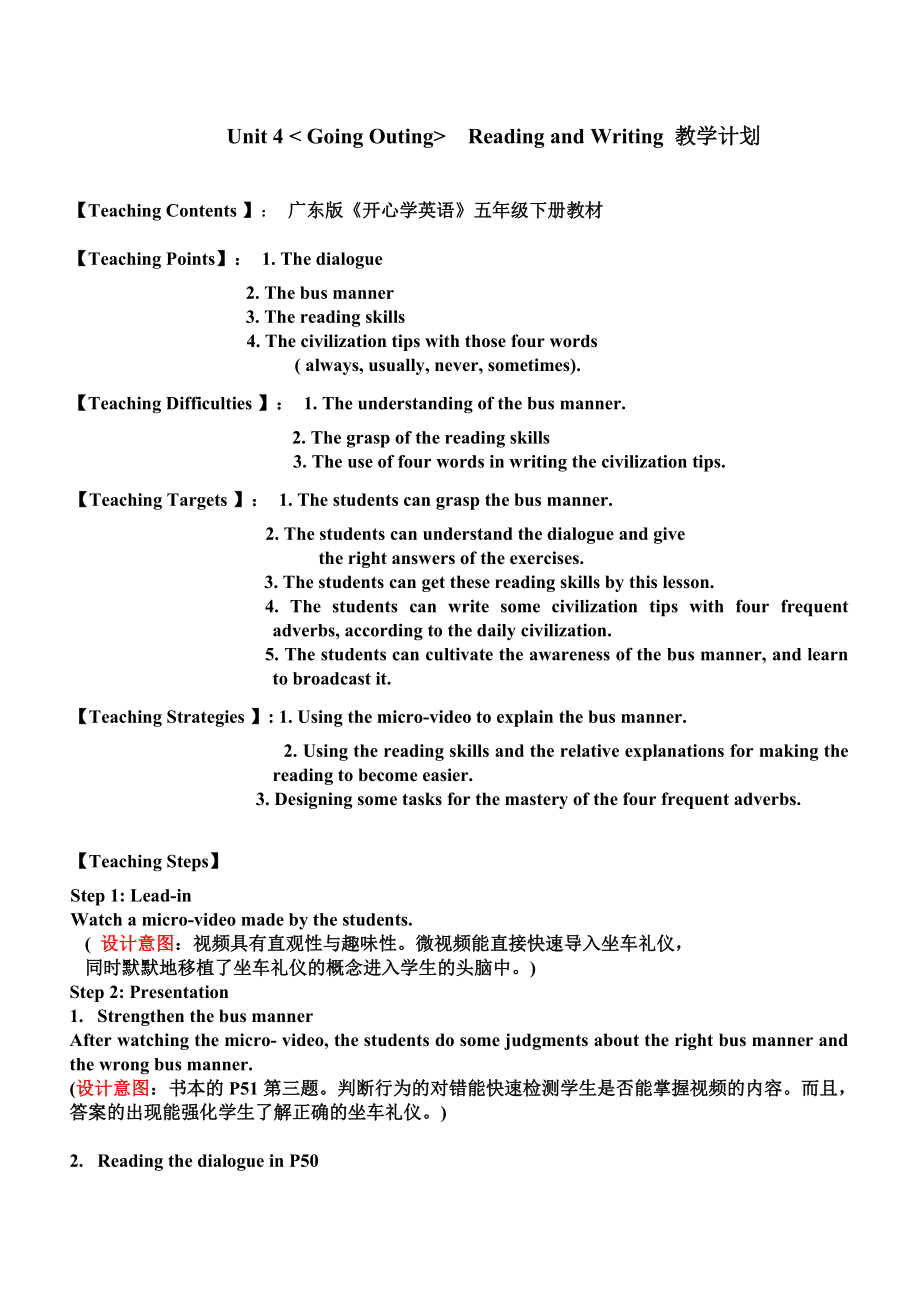《Unit4 reading and writing教學(xué)設(shè)計(jì)》由會(huì)員分享�����,可在線閱讀�,更多相關(guān)《Unit4 reading and writing教學(xué)設(shè)計(jì)(3頁(yè)珍藏版)》請(qǐng)?jiān)谘b配圖網(wǎng)上搜索。
1�����、
Unit 4 < Going Outing> Reading and Writing 教學(xué)計(jì)劃
【Teaching Contents 】: 廣東版《開(kāi)心學(xué)英語(yǔ)》五年級(jí)下冊(cè)教材
【Teaching Points】: 1. The dialogue
2. The bus manner
3. The reading skills
4. The civilization tips with those four words
( always, usually, ne
2、ver, sometimes).
【Teaching Difficulties 】: 1. The understanding of the bus manner.
2. The grasp of the reading skills
3. The use of four words in writing the civilization tips.
【Teaching Targets 】: 1. The students can grasp the bus manner.
3�����、 2. The students can understand the dialogue and give
the right answers of the exercises.
3. The students can get these reading skills by this lesson.
4. The students can write some civilization tips with four frequent adverbs, according to t
4����、he daily civilization.
5. The students can cultivate the awareness of the bus manner, and learn to broadcast it.
【Teaching Strategies 】: 1. Using the micro-video to explain the bus manner.
2. Using the reading skills and the relative explanations for ma
5、king the reading to become easier.
3. Designing some tasks for the mastery of the four frequent adverbs.
【Teaching Steps】
Step 1: Lead-in
Watch a micro-video made by the students.
( 設(shè)計(jì)意圖:視頻具有直觀性與趣味性����。微視頻能直接快速導(dǎo)入坐車禮儀�,
同時(shí)默默地移植了坐車禮儀的概念進(jìn)入學(xué)生的頭腦中。)
Step 2: Presentation
1. S
6���、trengthen the bus manner
After watching the micro- video, the students do some judgments about the right bus manner and the wrong bus manner.
(設(shè)計(jì)意圖:書本的P51第三題��。判斷行為的對(duì)錯(cuò)能快速檢測(cè)學(xué)生是否能掌握視頻的內(nèi)容�。而且�����,答案的出現(xiàn)能強(qiáng)化學(xué)生了解正確的坐車禮儀。)
2. Reading the dialogue in P50
For answering this question, the students need to liste
7����、n and read the dialogue.
The question: Whether do Xiaoqiang and his mother know the bus manner?
(設(shè)計(jì)意圖:讓學(xué)生帶著問(wèn)題去閱讀能讓學(xué)生從材料中獲取信息,更能讓學(xué)生有目的性地去閱讀材料���。而且�����,邊聽(tīng)邊閱讀能在一定程度上降低閱讀的難度��,也增強(qiáng)了學(xué)生的英語(yǔ)輸入��。)
3. Understanding the dialogue.
After reading the dialogue, the students do some exercises.
(設(shè)計(jì)意圖:書本P51的三道題能檢測(cè)學(xué)生是否能理解
8�、對(duì)話�。)
4. Learning the reading skills.
The students learn the reading skills by analyzing the dialogue and the exercises.
The reading skills: 1. 看圖猜主題 2. 按詞填空 3. 小細(xì)節(jié)很重要,回頭檢查很需要
(設(shè)計(jì)意圖:針對(duì)學(xué)情設(shè)計(jì)了三個(gè)閱讀技巧��,并把他們?cè)O(shè)計(jì)得朗朗上口���。朗朗上口的閱讀口訣會(huì)促進(jìn)學(xué)生對(duì)這三個(gè)技巧的記憶。并且�,利用剛學(xué)的對(duì)話內(nèi)容和練習(xí)內(nèi)容來(lái)講解更能有助學(xué)生理解這三個(gè)技巧���。)
5. Concluding and revi
9、ewing four words.
The students review two frequent adverbs( always, sometimes) in the dialogue, and they review more frequent adverbs ( usually, never).
(設(shè)計(jì)意圖:借用對(duì)話復(fù)習(xí)四個(gè)頻率副詞���。學(xué)生可以從中更好地了解頻率副詞的用法��。)
6. Consolidation
According to the bus manner, the students write some civilization tips with four f
10��、requent adverbs.
(設(shè)計(jì)意圖:利用四個(gè)頻率副詞����,寫幾個(gè)針對(duì)坐車禮儀的文明小提示����。這不僅可以訓(xùn)練了學(xué)生的寫作能力,同時(shí)也是一種途徑讓學(xué)生宣揚(yáng)坐車禮儀�。)
7. Extensional homework
The students are asked to write some civilization tips with four frequent adverbs, in accordance of the daily manner.
(設(shè)計(jì)意圖:寫其他相關(guān)的文明小提示有助于學(xué)生觀察日常的文明行為����,更多地培養(yǎng)他們文明生活的意識(shí)。結(jié)合四個(gè)頻率副詞強(qiáng)化學(xué)生對(duì)這個(gè)四個(gè)詞匯的
11�����、使用。)
檢測(cè)練習(xí):
1. 書本P51 第三題
2. 書本P50 第二題
3. Rush to get a seat, jump and push, don’t wait in line,
Wait in line, say “Excuse me”, give the seat to elderly people or children
We always ____________.
We never ______________.
We sometimes _____________......
 Unit4 reading and writing教學(xué)設(shè)計(jì)
Unit4 reading and writing教學(xué)設(shè)計(jì)

